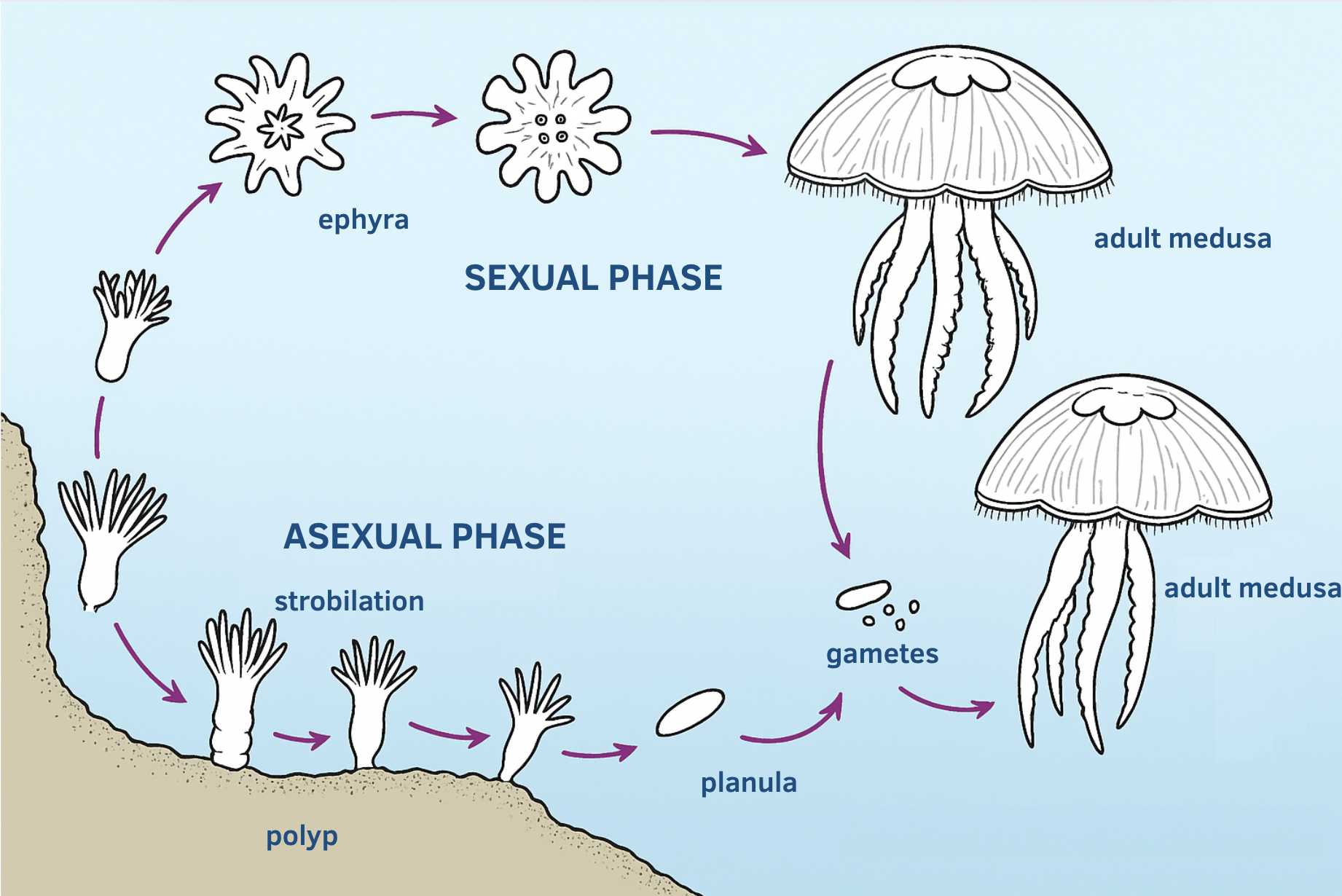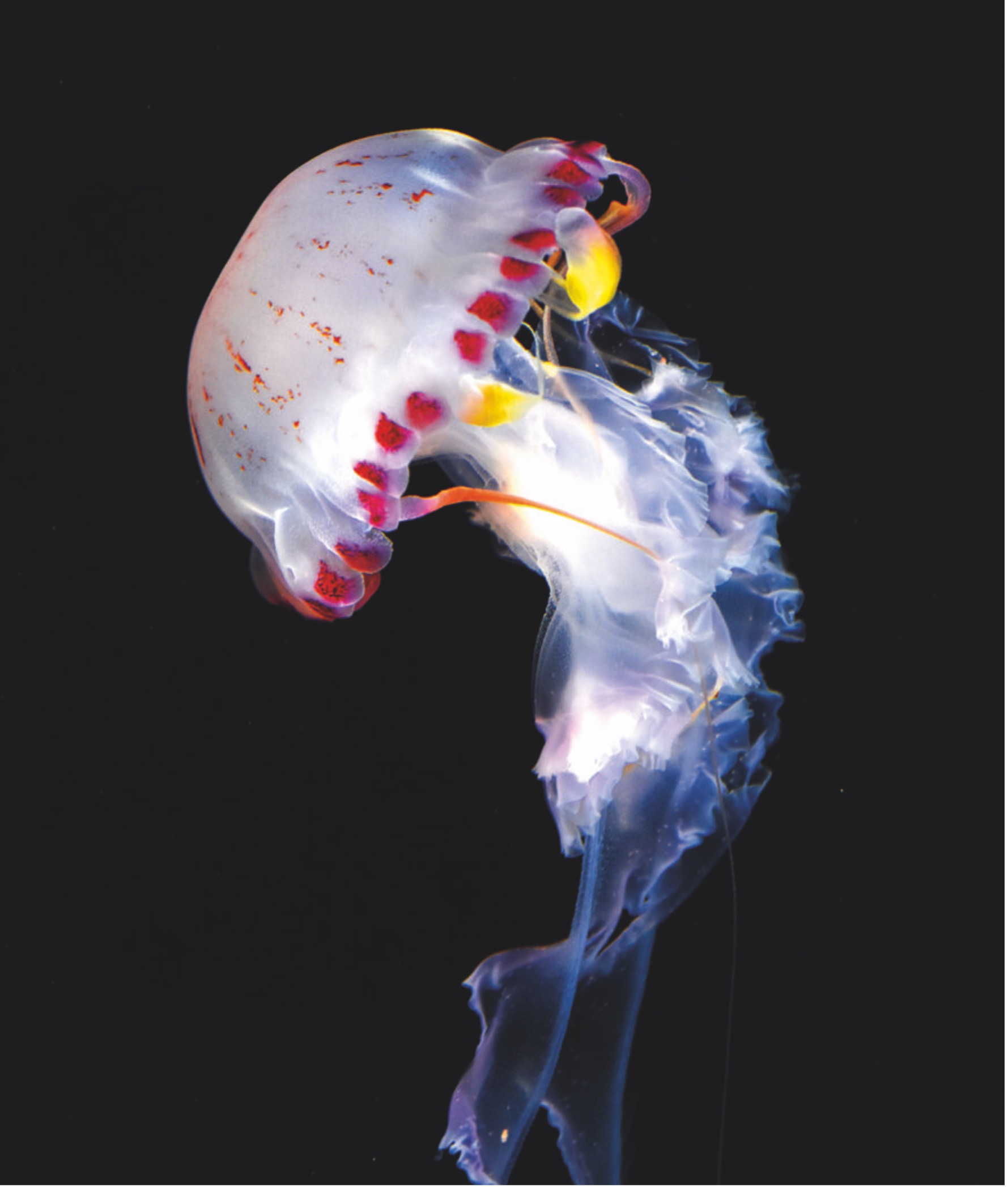Jellyfish are among the oldest and most mysterious creatures on Earth, having drifted through the oceans for more than 500 million years. In fact, they are considered one of the most ancient animal groups still in existence. These gelatinous beings, belonging to the phylum Cnidaria, inhabit almost every marine environment – from warm surface waters to the icy depths of the sea – and are remarkably well adapted to a wide variety of conditions.
In this article, we dive into the fascinating world of jellyfish and explore the vital role they play in marine ecosystems, helping to maintain both the balance and the health of our oceans.
Feeding habits of jellyfish
Jellyfish are marine creatures with a relatively simple way of feeding.
Although their diet varies according to species and size, most are carnivorous and act as opportunistic predators. They rely on the wind and ocean currents to bring food within reach, which they then capture using their tentacles. These tentacles are lined with stinging cells capable of immobilising prey and guiding it straight into the mouth.
What is particularly striking is that the largest jellyfish can swim vertically, thereby broadening their feeding range. This allows them to capture crustaceans, small fish and even other, smaller jellyfish. While plankton is usually their main food source, the size of each jellyfish ultimately determines its potential prey: the bigger the jellyfish, the larger the prey likely to be ensnared in its tentacles.
By understanding how jellyfish feed, we gain a deeper appreciation of their role in the oceans. They stand as a clear example of the adaptability and resilience of marine life.
How do jellyfish hunt?
In general, their hunting strategy is straightforward: they drift along with ocean currents and use their tentacles, armed with stinging cells, to paralyse any organisms that encounter them. These cells (known as cnidocytes) release toxins that immobilise prey almost instantly. The tentacles then guide the prey towards the mouth, where digestion begins inside the gastrovascular cavity.
Some jellyfish, such as box jellyfish (Cubomedusae), can detect light and actively move towards areas with a higher concentration of prey. Others form swarms to feed collectively.
Venom is released immediately, paralysing the prey. The tentacles then transport it to the mouth, where digestion starts within the gastrovascular cavity. Thanks to digestive enzymes, the food is broken down and absorbed, ensuring the jellyfish’s nutrition.
When it comes to hunting strategies, some species are active hunters while others are more passive. Active hunters, such as those belonging to the order Rhizostomea, lack tentacles on their bell. Instead, they possess eight highly branched oral arms. By pulsating their bell, they generate water currents that draw prey towards these arms, where they are trapped through filtration.
The second method is typical of jellyfish with tentacles extending directly from the bell. These species tend to be more passive, drifting or moving slowly; when a prey item meets the tentacles, it is immobilised by the stinging cells and then carried towards the mouth.
Ultimately, through these varied techniques, jellyfish exert a considerable influence on marine ecosystems. They can even alter the dynamics of food chains, which highlights their remarkable adaptability.
Reproduction of Jellyfish
Beginning with the sexual phase, many jellyfish species have separate sexes — there are male and female jellyfish. In some, males release sperm into the water, which then travel until reaching the females’ gastric cavity. In other cases, fertilisation occurs directly in the water (external fertilisation).
From there, the sperm reach the female gonads, where they fertilise the eggs. The fertilised egg then develops into a ciliated larva known as a planula, which swims freely until it finds a suitable surface, where it eventually settles.
Once attached, the planula transforms into a polyp — an immobile stage that serves as the foundation for later development. Over time, the polyp grows and begins to divide — either through budding or strobilation — releasing small jellyfish known as ephyrae. These ephyrae then grow into adult medusae, completing a continuous life cycle.
Altogether, this complex process ensures the continuity of the species and highlights the extraordinary diversity and adaptability of the jellyfish life cycle.
That said, some species do not go through the polyp stage — as in most members of the class Cubozoa (box jellyfish).

Image source: own elaboration
Fun facts about jellyfish
Jellyfish are animals full of peculiarities that make them both fascinating and unique. Below is a list of seven remarkable characteristics of these aquatic creatures:
- Ancient origins– Jellyfish have existed for more than 500 million years, making them among the very first multicellular animals to inhabit the oceans.
- Mostly water– Around 95–98% of a jellyfish’s body is made up of water, which explains its translucent, gelatinous appearance.
- No brain or heart– Although they lack complex organs, jellyfish possess a simple nervous system that allows them to react to stimuli and hunt effectively.
- Giant jellyfish– The lion’s mane jellyfish is one of the largest in the world. Its tentacles can grow up to 36 metres in length, making it a true giant of the seas.
- Potentially immortal– The jellyfish Turritopsis dohrnii can revert to its juvenile stage after reaching maturity, effectively avoiding death from ageing.
- Passive hunters– They are excellent passive hunters, capturing prey with their stinging tentacles while relying on ocean currents to bring food within reach.
- Key ecological role– Jellyfish are both predators and prey in marine food chains, and some species even serve as floating nurseries for small fish.
Discover jellyfish at Loro Parque
At Loro Parque, jellyfish take centre stage in a fascinating underwater journey. Here you can observe a variety of species up close, each one revealing the mysteries of its beauty and its essential role in maintaining the balance of marine ecosystems.
In addition, through Loro Parque Fundación, we support conservation projects for animals that act as natural predators or regulators of jellyfish populations, such as sea turtles. We also work alongside the Government of the Canary Islands on initiatives to tackle climate change – a crucial challenge in protecting our oceans.
We invite you to enjoy this unique experience at Loro Parque, where you will discover more about these extraordinary creatures and the positive impact we can all create together in preserving the seas. Don’t miss it!













